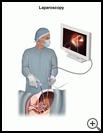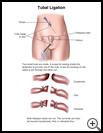
Laparoscopy for Tubal Ligation
________________________________________________________________________
KEY POINTS
- A laparoscopy is a procedure done to look inside the belly or pelvis using a lighted tube and a camera to see your organs. You will have anesthesia to keep you from feeling pain. This procedure is done to block your fallopian tubes.
- Follow any instructions your healthcare provider gives you about eating, drinking, and taking your medicines before the procedure.
- Ask your healthcare provider about what risks apply to you. Be sure to discuss any other questions or concerns you may have.
________________________________________________________________________
What is a laparoscopy for tubal ligation?
A laparoscopy is a surgical procedure that uses a small lighted tube put into the belly through a small cut to look at the organs and tissues inside the belly. This procedure is done to block your fallopian tubes. The fallopian tubes carry eggs to the uterus. Blocking the tubes prevents pregnancy because it stops sperm from reaching and fertilizing eggs. It also keeps eggs from reaching the inside of the uterus (womb). People often refer to this procedure as "having your tubes tied" or sterilization.
Recovery from a laparoscopy is usually quicker than if you have the procedure done through a larger cut in your belly (open abdominal surgery).
Closing of the fallopian tubes is a very reliable and permanent form of birth control. Blocking the tubes may also help prevent a serious infection called pelvic inflammatory disease.
When is it used?
Healthcare providers generally recommend a permanent form of birth control, such as tubal ligation, only if:
- You don’t want to have any more pregnancies
- Being pregnant might be dangerous to your health
- You have a high risk of passing on a serious genetic disease
- You cannot use other birth control methods
Ask your healthcare provider about your choices for treatment and the risks. It’s important to remember that you should have this procedure only if you are sure you do not want to get pregnant again. Ask your healthcare provider about all forms of birth control to decide what is best for you.
Tubal ligation does not protect you against sexually transmitted diseases, such as AIDS. Latex or polyurethane condoms are the best way to protect against sexually transmitted infection.
Tubal ligation does not change your menstrual cycle or sexual function.
How do I prepare for this procedure?
- You may have a pregnancy test before the surgery.
- Make plans for your care and recovery after you have the procedure. Find someone to give you a ride home after the procedure. Allow for time to rest and try to find other people to help with your day-to-day tasks while you recover.
- Follow your provider's instructions about not smoking before and after the procedure. Smokers may have more breathing problems during the procedure and heal more slowly. It is best to quit 6 to 8 weeks before surgery.
- You may or may not need to take your regular medicines the day of the procedure. Tell your healthcare provider about all medicines and supplements that you take. Some products may increase your risk of side effects. Ask your healthcare provider if you need to avoid taking any medicine or supplements before the procedure.
- Tell your healthcare provider if you have any food, medicine, or other allergies such as latex.
- Your healthcare provider will tell you when to stop eating and drinking before the procedure. This helps to keep you from vomiting during the procedure.
- Follow any other instructions your healthcare provider gives you.
- Ask any questions you have before the procedure. You should understand what your healthcare provider is going to do. You have the right to make decisions about your healthcare and to give permission for any tests or procedures.
What happens during the procedure?
You will be given a local or general anesthetic before the procedure to keep you from feeling pain. Local anesthesia numbs part of your body while you stay awake. You may be given medicine with the local or regional anesthetic to help you relax. General anesthesia relaxes your muscles and you will be asleep.
Your healthcare provider will make a small cut near your bellybutton. Your healthcare provider will put the laparoscope through the cut. Your provider may put other tools through other small cuts in your belly. Your provider will then use the tools to cut and tie the fallopian tubes or block them in another way. For example, they might be sealed with an electric current (electrocautery), or clips or elastic rings may be used.
At the end of the procedure, your provider will remove the scope and all other tools, and close the cuts.
The procedure will take about 20 to 30 minutes.
What happens after the procedure?
You may stay in the hospital several hours and possibly overnight to recover.
You may have some pain, nausea, vomiting, or constipation after the procedure. Your healthcare provider may give you medicine or recommend other ways to treat these problems.
If you were using birth control pills before the tubal ligation, you may notice changes in your periods now that you are no longer taking birth control pills. Tell your healthcare provider if your menstrual periods don’t go back to a regular pattern within 3 months or if there are other changes after this procedure.
If you change your mind and later want to get pregnant, you will need another operation. Surgery to unblock your tubes may not be successful. It is best to use tubal ligation as a permanent method of birth control.
Ask your healthcare provider:
- How long it will take to recover
- If there are activities you should avoid and when you can return to your normal activities
- How to take care of yourself at home
- What symptoms or problems you should watch for and what to do if you have them
Make sure you know when you should come back for a checkup. Keep all appointments for provider visits or tests.
What are the risks of this procedure?
Every procedure or treatment has risks. Some possible risks of this procedure include:
- You may have problems with anesthesia.
- You may have infection or bleeding.
- Other parts of your body may be injured during the procedure
- There is a slight possibility that you could still get pregnant. If you do get pregnant after having a tubal ligation, the chances of a pregnancy outside the uterus (usually in the tubes) is higher than if you had not had a tubal ligation. You may then need surgery to remove the pregnancy from your tubes. Be sure to tell your provider if you think you might be pregnant after this procedure.
Ask your healthcare provider how the risks apply to you. Be sure to discuss any other questions or concerns that you may have.


